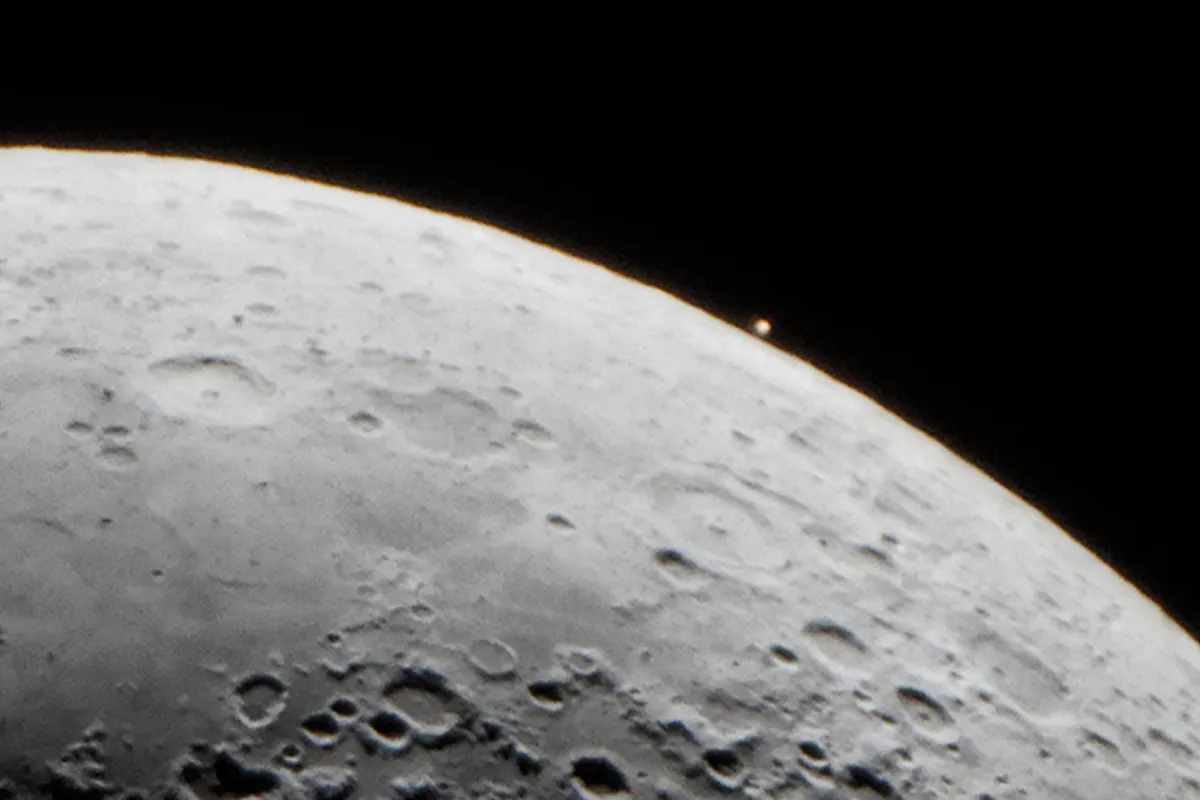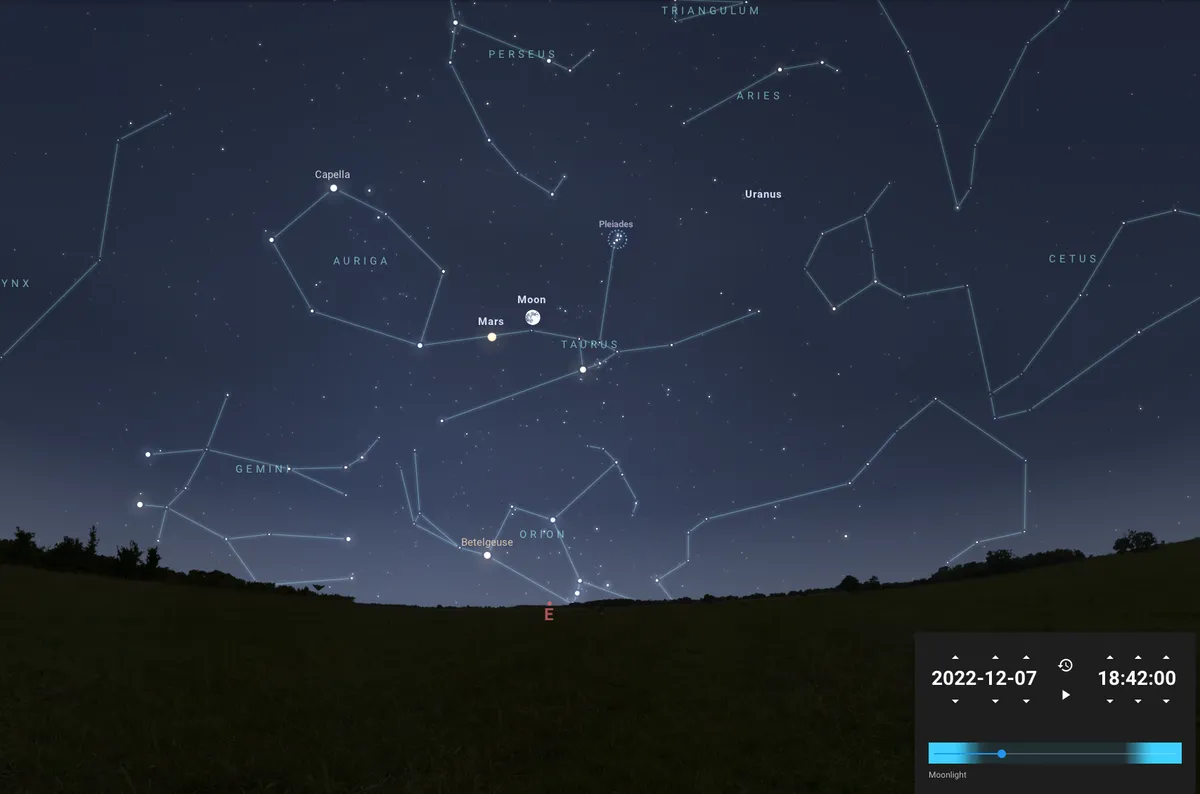On a clear night, the vast skies can be strikingly beautiful. Just the act of looking up at the stars can get us involved with astronomy. Most of the stars appear white to us, but as Orion rises higher into the sky throughout the winter months, the red glow of the supergiant Betelgeuse is easily distinguishable. So too is the reddish-orange Aldebaran in Taurus, but unlike Betelgeuse and Aldebaran, Mars doesn't twinkle. Instead, it shines with a steady reddy-orange light.
As Mars comes into opposition tomorrow morning, Earth will lie directly between Mars and the Sun, and the Red Planet will remain in the sky above the horizon for most of the night, making it an excellent time to view, clouds permitting.
If you’re still able to enjoy the warm weather and (relatively) clear nights, why not make the most of them with ourfull Moon UK calendarandastronomy for beginners guide?
What is opposition?
Opposition is the planetary equivalent of a full Moon. When a planet is close to the Earth, and on the opposite side of the Earth to the Sun, we say that planet is in opposition. In the same way that sunlight is fully reflected during the full Moon phase in the lunar cycle, the sunlight that shines on the planet is also fully reflected.
"Opposition is a big deal for Mars. Because apart from putting a planet in a position where it’s visible all night long, this is also when it appears brightest and, through the eyepiece of a telescope, largest," explains astronomer and BBC Sky at Night presenter Pete Lawrence.

"All superior planets – the term describing planets with larger orbits than Earth – reach opposition, but the improvement in visibility is particularly dramatic for ‘nearby’ Mars," he says.
Only those planets that are beyond Earth's orbit can be in opposition: Mars, Jupiter, Saturn, Uranus and Neptune. Because Mercury and Venus orbit the Sun inside the path of Earth's orbit, they can never be in opposition. This is because the Earth will never be situated between them and the Sun.
When is Mars in opposition?
Mars will reach opposition on the morning of 8 December 2022, when it will be at its brightest for the year, essentially creating a 'full' Mars. The Red Planet comes closest to Earth a week earlier, on 1 December. At this time, Mars will be just 81.45 million kilometres away from the Earth.
Opposition can occur at any point along Mars' elliptical orbit, so the distance between Earth and Mars can vary year on year. If you remember the 2003 opposition, then you'll also remember it was the closest approach in a whopping 60,000 years!
The precise time that Mars reaches opposition will be 5:42am on the morning of 8 December 2022, reaching an apparent magnitude of -1.9. From our point of view, Mars will appear brighter than Saturn in the night sky... however, we won't be able to see it at this time. So if you want to spot Mars, the best time will be earlier that night, or in the evening of 7 December.
Mars will rise at 3:24am this afternoon, on Wednesday 7 December 2022 and will remain above the horizon until it sets at 8:15am on 8 December, as viewed from London (times will vary with location).
The next time Mars reaches opposition will be on 16 January 2025.
What's so special this year?
This year, opposition occurs at the same time as a lunar occultation.
"Excitingly, from the UK in the early hours of 8 December, the full Moon appears to move in front of Mars, hiding it from view; a rare event known as a lunar occultation of Mars. This event will be visible to the naked eye, as well as through binoculars and telescopes. From the centre of the UK, Mars disappears at 4:54am, before reappearing just over an hour later at 5:56am," explains Lawrence.

The occultation should be visible across the whole of North America and Western Europe. Here in the UK, we should be able to see a bright Mars slipping behind the fully illuminated Cold Moon, before reappearing on the other side.
"Times will vary slightly with different locations, so start viewing approximately 20 minutes before the stated times to ensure you don’t miss anything."
Weather permitting, we are expected to be offered good visibility of Mars... unless you happen to look up when Mars is hidden behind the Moon.
How do astronomers use opposition?
When a planet is in opposition, this gives astronomers a brilliant opportunity to monitor it, gathering as much information and data while it's in this position.
"When a planet is in opposition, we're seeing the disc of Mars larger than it normally is from Earth. Astronomers monitor the weather on Mars, as well as changes in the atmosphere, and this is sometimes easier to do from Earth than it is from a spacecraft."
"From Earth, you see Mars as a whole planet; a spacecraft just sees little bits of the planet as they fly over it, and then stitch it all together later," explains astronomer Dr Stu Clark.
On Mars, there's an interplay between the variable seasons, the icecaps, and the thickness of the atmosphere, so gathering data is important in helping us understand this relationship.
How often does Mars go into opposition?
"After Earth, Mars is the next furthest planet from the Sun. It takes 687 days for the Red Planet to complete one orbit. This means that from Earth, it appears to lie in the opposite part of the sky to the Sun, once every 2.1 years," says Lawrence.
That's roughly once every 25-26 months.
The rest of the outer planets go into opposition on an annual basis, with Jupiter going into opposition every 13 months, moving through each of the Zodiac constellations in turn as it does so.
How can I spot Mars in the night sky?
At the moment, Mars is one of the brightest objects in the night sky, making it relatively easy to spot even without a pair of binoculars or a telescope. If you don't fancy star hopping, or you're not sure which direction you're looking, then there are astronomy apps that you can download - just point your phone at the sky, and the app will tell you what you're looking at.
If you want to see Mars, look towards the east-northeast when it's dark, just after sunset. Mars will already be above the horizon at this point and in the constellation Taurus.
"Mars is visible, bright and distinctly orange in colour, above the eastern horizon. Mars is currently moving against the stars of Taurus the Bull, and this places it near two bright and similarly orange-hued stars, Aldebaran in Taurus and Betelgeuse in Orion," says Lawrence.

"Mars is very obvious in the night sky at the moment, it's very easy to notice. You can trace it across the sky, over towards the west and see Jupiter. Then, if you go further, you'll see Saturn as a slightly dimmer ochre dot, right in the west," adds Clark.
If you want to watch the occultation, you'll need to get up early (or stay up late!) on the morning of the 8 December. The winter constellation Orion will have risen by this time, so you can easily find Taurus by looking above Orion. Mars will be nestled to the top-left of the full Cold Moon with Beta Tauri (aka Alnath) in Taurus almost directly above.
During the occultation, Mars will appear to get closer to the Moon, sinking down towards the horizon, before disappearing completely as it passes behind the Moon. Mars will then reappear to the bottom-right of the Moon, in the still-dark, pre-dawn sky.
Read more about Mars: